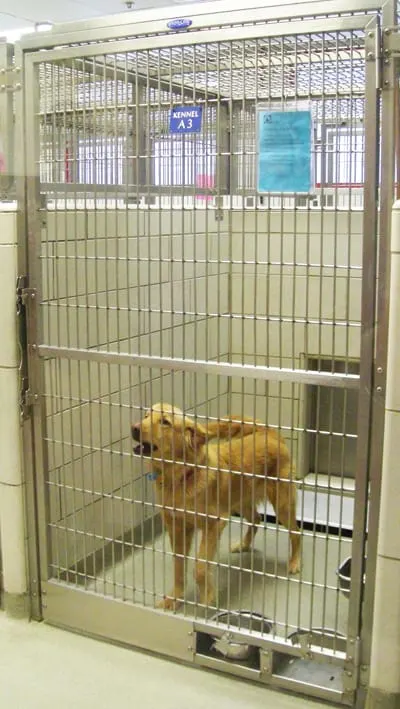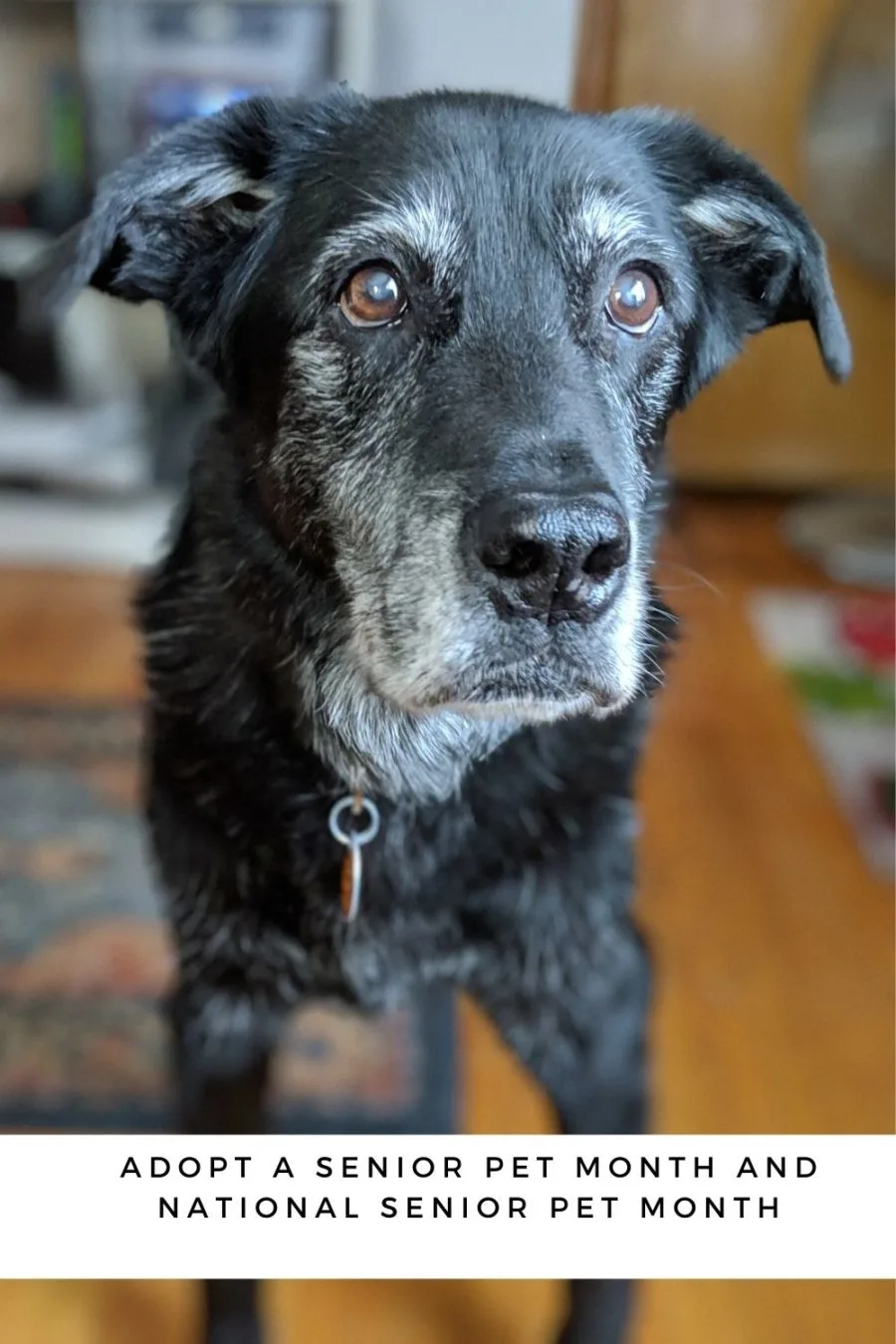November is both Adopt a Senior Pet Month, an ASPCA pet observance, and National Senior Pet Month. Any time is a good time to consider adopting a senior dog–and we’ve got the veterinary advice and dog trainer advice below to prove it!

Why are senior pets in shelters?
Often the last pets to be adopted, senior pets find themselves homeless for numerous reasons.
Owners, through death or a change in living situation such as admission to a nursing home, may no longer be able to care for an aging pet.
Or older pets may have been surrendered because owners grew tired of their pets or decided they once again wanted a puppy or kitten.
However they arrived at the shelter, most senior pets have one thing in common: they previously lived with a family and would like to once again. Their experience with family living makes senior pets easy to integrate into a new home, just one of the many reasons to adopt a senior pet.
10 Reasons to Adopt a Senior Dog
If you’d like to skip the puppy issues, adopting a senior dog can be the answer. Often overlooked in shelters, senior dogs generally wait far longer for adoption than their younger counterparts. They linger in shelters where they sometimes need veterinary care.
Dogs can remain vibrant and active well into their senior years. Our previous dog, Hershey, loved frolicking on chilly days throughout her 15 years in our hearts and home:

Today we want to share with you 10 reasons to consider a senior dog for your next adoption:
 1. What you see is what you get.
1. What you see is what you get.
Mixed breed dogs are our personal favorite but, with a mixed breed puppy, you often don’t know just how large the puppy will grow. With a senior dog, what you see is what you get! If size is a deciding factor in adoption, adult and senior dog adoption offers a big advantage.
2. Skip the puppy problems.
Sure puppies are cute–but are you forgetting the problems that come with puppies: chewing, boundless energy, crying, chewing, housetraining issues…and did I say chewing? Skip that stage with a senior.
3. Save time and money.
Adoption of a senior dog is often less expensive than a puppy.
Besides the “sticker price” of the adoption, you’ll also save money in terms of immunizations.
While shelter puppies will have received vaccines appropriate to their age, they’ll often still need additional shots after adoption. Skip that extra expense by adopting a senior who will have received shots in the case of most shelters.
4. Skip the spay and neuter surgery, in many cases.
Some shelters don’t spay and neuter very young pups, waiting until they’re a bit older for the surgery. (That may mean that you foster to adopt, and the adoption isn’t finalized until you return with the puppy for surgery. That happened to us in the case of our kitten, Lucky.)
That’s not a factor with seniors; if the shelter spays and neuters before adoption, the senior will already have received the surgery, if he didn’t already arrive at the shelter neutered.
5. Skip the teenage years.
Teenagers can be a challenge–and that includes teen dogs.
From age 6 months to two years, an adolescent dog is figuring out his role in the world and, sometimes, challenging yours.
Skip that awkward stage with a senior who is confident and ready to be your buddy.
6. Training might be a bonus.
You may get a senior dog who is already trained–housetraining, leash training and more.
7. You may learn more about the dog’s personality.
Some senior dogs have been with shelters and rescues for extended periods, during which the shelter professionals can better access his personality.
Shelter puppies are often adopted as soon as they’re available.
8. You can rest.
While some seniors retain their higher activity level, many are happy to rest and relax with you.
Want to be a couch potato for a while after work? A senior dog will be happy to hang out and watch TV with you.
Senior dogs have been through those difficult times that try even the most devoted pet lover, from chewing to adolescent stubbornness. They’ve mellowed into an animal that’s happy to do what they do best: be a buddy.
9. You’ll save a life.
Senior dogs don’t have many opportunities for adoption at shelters; they’re often overlooked time and time again.
10. You’ll be a senior one day.
We’ll all grow old one day; what would you like your senior years to be like? Get some karmic brownie points by giving a senior the golden years you hope you’ll one day enjoy.
Veterinarian Tips on Adopting a Senior Pet

Heather Loenser, DVM, Staff Veterinary Advisor, Professional and Public Affairs for the American Animal Hospital Association, provides this insight into adopting a senior dog or other pet:
If we had the choice, our pets would live as long as we do, but sadly, that’s not the case. All members of the animal kingdom age at different rates. Hamsters rarely live past 3 years of age, yet tortoises and parrots can live to more than 50 years. King Tut, the salmon-crested cockatoo who greeted visitors to the San Diego Zoo for decades, lived to the ripe old age of 67. Many pet owners actually include these long-lived companions in their wills.
When it comes to dogs and cats, each breed, or breed mix, ages differently, both mentally and physically. In general, the larger the breed or size, the shorter the lifespan. A Pekingese is considered a senior at 8 years old while a Great Dane hits the senior mark at age 5.
We at the American Animal Hospital Association maintain that a dog’s and cat’s senior years are the last quarter of its life, but these pets still can have many years to enjoy a rich life. So, if you’re thinking of adopting a pet, think “senior,” and now’s the time: November is “Adopt a Senior Pet Month.”
Why adopt a senior? He has a leg up on a younger pup or kitty.
Senior cats and dogs have been around the block a few times, and that gives them a leg up, as they come with a lot of perks:
- They’re predictable roommates. Many already know what it’s like to share a home with kids or other furry friends and are less likely to chew your shoes, swallow your socks or leave “accidents” on the floor.
- Most seniors are familiar with basic obedience commands.
- Seniors are a lot calmer since the antics of youth are far behind them.
- They really appreciate you! These “second- hand” dogs and cats may have just lost their family or have never known love, so they seem more grateful for your love and attention than their younger counterparts.
Before you say yes to a new dog or cat, choose the breed that best suits your lifestyle.
It’s important to do a little “homework,” before you choose your new pet. Think long and hard about what you really want.
If you’re looking for an active dog who will spend time with you swimming, hiking, and chasing balls, choose a 6-12 year old breed or mixed-breed like a Labrador, Pointer, Hound or Pit Bull.
If you’d prefer a companion who’d rather lounge on the sofa keeping you warm and showering you with love, a Greyhound is a great bet! Believe it or not, retired racing Greyhounds are huge couch potatoes!
If you’d like your pet to accompany you when you grab a coffee, go to the bank…or sit next to you on a plane, opt for a tiny dog, like a Chihuahua or Poodle mix. These breeds can be content traveling in a comfy carrier.
And if you’re thinking small, maybe a cat is the way to go. What’s great about adopting an older cat is that his behavior remains relatively the same throughout his life. Cats are famous for hiding the signs of aging. Plus…many cat breeds, like Burmese, Abyssinian and Manx have similar personality traits to dogs. You can find these breeds in breed-specific rescues. Some may be harder than others to locate, but breed rescue organizations are eager to help you find what you’re looking for.
And finally, if you’re a caregiver at heart, consider rescuing a dog or cat who needs special attention. There are many rescue organizations that specialize in finding homes for special needs pets.
Another reason to adopt a senior? Advancements in veterinary medicine help them live longer, healthier lives.
Veterinary medicine has reached a golden age, especially in our ability to treat pets in their golden years. This is especially good news since our pets are living well past what used to be considered a normal life span.
Many prospective pet parents seek my advice, voicing concern about caring for an older pet’s health, but truthfully, many seniors simply need love, exercise and preventive care from a veterinarian. Your veterinarian may follow the American Animal Hospital Association’s Senior Health Care Guidelines for Dogs and Cats which specifies the kind of care and testing older pets typically need.
Veterinarians now have access to cutting-edge treatments including pain management, MRIs and chemotherapy, kidney transplants, acupuncture and herbal therapies.
Once you bring your new senior home, schedule a visit with your veterinarian. He or she can identify pre-existing diseases and diseases that could have been transmitted within the shelter.
Depending on the age of the pet, the vet may recommend repeating a physical exam and laboratory testing every year if the pet is middle aged, or every six months if he’s a senior.
There are well-established guidelines for the veterinary care for dogs and cats depending on their life-stage.
Senior pets and senior people develop many of the same diseases.
As pets age, they can develop health problems similar to those in elderly people. These include cancer, heart disease, kidney/urinary tract disease, liver disease, diabetes, joint or bone disease, senility, and weakness.
Keep a watchful eye on your pet to see if he exhibits any of these symptoms:
- Difficulty climbing stairs or shows limited mobility
- Refusing to eat for more than 18-24 hours
- Acting confused or “spacey”
- Panting or coughing when exercising
- Showing a reluctance to exercise
- Exhibiting a swollen abdomen, or appearing “suddenly” overweight
- Drinking more than usual
Schedule an appointment with your vet if you notice any of these symptoms. Many of these diseases, if identified early, can be treated simply and in a cost-effective manner. To find a hospital accredited by the American Animal Hospital Association near you, use this hospital locator.
Investing time and energy to enrich the life of an adoptable senior will bring joy to your life as well…and may even make you pause and ask, “Who Rescued Whom?”
How to Keep Your Senior Dog Sharp
Shining a spotlight on National Adopt-A-Senior-Dog Month, famed animal trainer Bill Berloni — who has offered shelter dogs of all ages a second act in life as stars of stage and screen for decades — partnered with Purina Pro Plan to showcase the benefits of a good diet in keeping your senior dog sharp and active.
Berloni, who has gained fame by training dogs who have made the leap from shelter to stardom, offers tips to teach tricks to the four-legged celebrity in your life.
The high-profile pal to those with paws states: “Whether you have a young dog, senior dog, adopted dog, new dog or two dogs, training is the key to communicating with your canine family member. Here are some simple, easy to learn behaviors for you and your dog to start a two-way conversation. It is a series of behaviors that build upon one another to get the conversation rolling. So grab your Purina Pro Plan training treats, leash, patience and smile and let’s start training.”
If you’ve recently adopted a senior dog–or you want to keep your dog active, here are Berloni’s training tips:
Sit.
Simple, but important, this is the first thing I teach my dogs. Remember to be kind, consistent and clear.
With a treat in hand, say your dog’s name and lure your dog’s nose up with the teach hand as you gently push their rear end down and say “sit” once.
Quickly your dog will follow your hand up in front of their nose and avoid the push at the other end. If your dog does not sit, make sure you are luring them correctly.
If they still do not do it, start over again by saying their name and giving them the command. They only get the reward when they do it right.
Keep practicing and eventually you will notice you won’t even need to raise your hand. All of a sudden your dog knows “sit.”
Stay.
Teaching “stay” is about teaching your dog to be patient.
With leash and treats in hand, ask your dog to sit. Say their name and “stay” and treat them immediately. In effect you are rewarding them for staying one second.
Each day in a week, add five seconds. Take your time – do not graduate five seconds until they are doing it perfectly.
Once you successfully get up to “stay” for twenty seconds, raise the stakes by putting distance between you and your dog. Say “stay” and take one step back and repeat the same graduation of time the dog stays put while treating him/her.
Once you’ve conquered “stay” one step back, go to two, three and so on. Pretty soon your dog will have conquered “stay” at various distances!
Up and down.
Put your dog on a leash and hold it at the buckle. In the other hand have a treat. Say their name, then say “down” and lure them to the floor gently putting pressure on the leash – once they get down give them the treat.
Get another treat and say their name and “up” while luring them with the treat and gently pulling up and giving them the treat as soon as they sit up.
Soon you will see they are avoiding the gentle pressure on the leash to get to the treat.
Wave.
This is a fun and simple behavior which dogs have a natural tendency to do. Usually most dogs will reach for something they want or extend a paw to solicit attention.
Simply get down on the floor with your dog. Hold the treat in one hand by your face, say their name and the word “wave” and gently lift their paw with your other hand.
Hold it for two seconds and then give the treat.
In no time at all, your dog will start to lift their paw on their own – when they do it by themselves immediately give them the treat. Before you know it, they will be hailing taxis in New York City!
Mind Games / Pick the Paw.
This is a mental stimulation game to get your dog’s brain working! Show your dog a treat and then put your hands behind you and switch the treat around. Bring both hands if front of you and let your dog choose. If your dog picks the correct hand, they win the treat, if not try again.
Pin it to remember Adopt a Senior Pet Month and National Senior Pet Month

- Review: Jimmy BX7 Pro Anti-Mite Vacuum Cleaner - December 16, 2024
- 🎉 GIVEAWAY: Lord of the Pets Portrait of Your Dog! - November 26, 2024
- Review: Lord of the Pets Portraits - November 17, 2024
